A popular proverb says: "The fish seeks where it is deeper, but the man where it is better." At all times, people sought to work in those countries where more could be gained for their labor. And today, a huge stream of labor migrants from Latin America are pouring into the United States, Arabs and residents Asian countries strive to get to work in the EU countries. Russia was not an exception, experiencing a constant influx of foreign labor from the CIS countries.
Reasons for labor migration to Russia
The CIS countries are highly differentiated by the standard of living of citizens, which is determined by the state of their economies and the instability of political systems. In most of them, in the post-Soviet period, living standards were constantly decreasing, production was curtailed, and unemployment was growing. Against this background, Russia stands out favorably with the stability of the economy (even despite the difficulties of the last period), the constant need for labor resources in certain sectors of the economy and the level of salary that is quite high by the standards of the CIS.
The geographical proximity of the Commonwealth countries to Russia, the presence of visa-free regime with most of them, the widespread use of the Russian language as a means of interethnic communication, numerous family and business ties, recognition of diplomas of higher and secondary technical education - all this, coupled with the aforementioned economic stability of Russia and contributes to the fact that labor migrants from the CIS countries are rushing in the Russian Federation.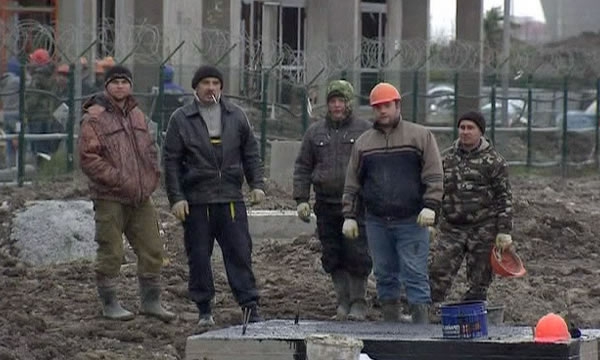
The role of labor migration
Migrant workers in Russia – it is a social and economic phenomenon with many facets. Their role in the development of the CIS countries is quite contradictory. The positive aspects include the fact that thanks to labor migrants, Russian trade, the construction and transport business, and agricultural production received a new breath, since they satisfy the demand for unskilled labor.
In addition, the labor activity of migrants in Russia generates an influx of substantial financial resources into their countries through the annual transfer and export from Russia of up to $ 15 billion.
So, 49% of Tajikistan’s GDP is made up of funds transferred by Tajiks working abroad, mainly in Russia. According to the World Bank, this is an absolute record among all countries of the world. Next is Kyrgyzstan with 32% of GDP generated from migrant transfers, followed by Moldova with 25% of GDP and Armenia with 21%.
Thus, labor migrants significantly reduce the balance of payments deficits of their countries.
However, there are negative aspects. Thus, illegal migrants feed the shadow economy with their labor, while legal migrants dump on labor market Russia, reducing wages. According to the FMS, in recent years, more than 4.3 million immigrants were illegally in Russia.
The formation of ethnic enclaves with their own internal laws of life, which often contradict Russian legislation, has acquired a very dangerous tendency. The local population forms a negative attitude towards such closed communities, as a rule, in response to the aggression of foreigners against Russians. In recent years, this has led to a series of excesses, resulting in spontaneous protests of the population against an increase in the number of immigrants in Russia.
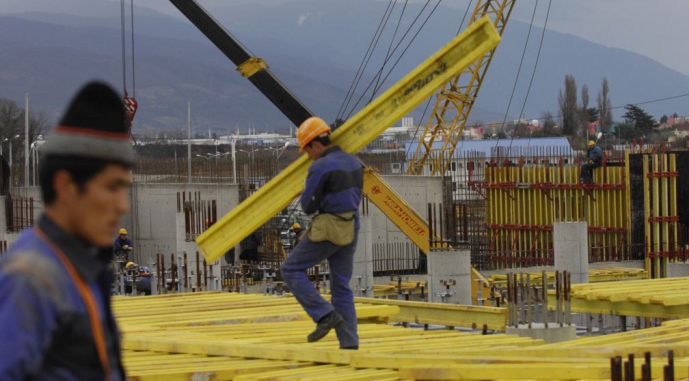
What's new for labor migrants brought in 2015
All of the above forced the Russian authorities to take urgent measures. In order to prevent labor migrants from striving to enter the country, the legislation has changed quite a lot since 2015.Now, migration from countries subject to visa-free entry is no longer regulated by quotas for foreign labor. There will be no more refusals of permission to work on exceeding quotas for this region. In exchange, economic measures have been introduced to regulate the number of foreign workers — they need to acquire patents for the right to work in Russia at their own expense (or at the expense of employers). In general, the new law on labor migrants dated November 24, 2014, which changed a number of provisions of the existing law on the rights of foreigners in the Russian Federation, aims to create a modern and civilized immigration system.
More than 20 legislative amendments have tightened immigration controls. Thirty days after the date of arrival at the place of intended work, a migrant must register with the FMS, make a notarized translation of his passport, pass an exam in the Russian language, history and the basics of Russian law, get a TIN, undergo a medical examination and buy medical insurance.
The fight against illegal migration has also become tougher: the ban on violators to enter the country has been increased to 5 or 10 years, and this measure has already touched 1.35 million citizens of the CIS countries.

Who will be affected by the new rules of labor migration?
The above rules are required to comply with labor migrants from the CIS countries, with the exception of Belarus, Kazakhstan and Turkmenistan. The first two states are members of the Customs Union, and their citizens can work in the Russian Federation without any special permits, and citizens of Turkmenistan enter the country with visas. The new rules also apply to citizens of Abkhazia and South Ossetia.
In connection with the latest events in Ukraine, about 1 million of its citizens, mainly refugees from the Donbass, drove into the Russian Federation in an emergency mass order. More than half a million of them issued RVPs and received military training in Russia. Registration of labor migrants - refugees from Ukraine - for work is done without patents. Unfortunately, many of them face the problem of registration (at least for a year) at the place of residence. Now the FMS has prepared a number of documents aimed at ensuring that, on the one hand, the labor rights of migrants from this category are protected, and on the other, that the Russian labor market does not get an additional burden.
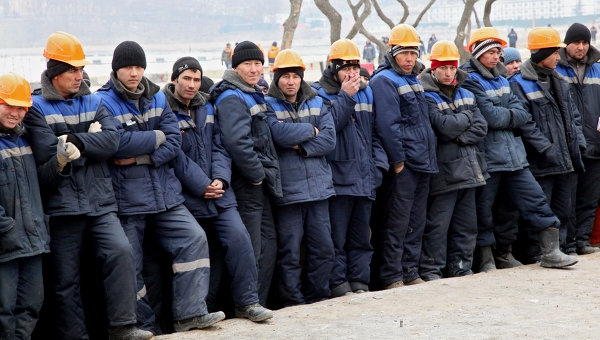
Procedure for obtaining a patent
When entering the Russian Federation, an immigrant must indicate the word “work” in the migration card in the column “Purpose of arrival”. If another purpose is indicated, the patent will not be given to him. Upon arrival at the place of work, the following procedures are performed:
- Registration for migration registration at the local branch of the FMS;
- a medical board consisting of 4 doctors: an infectious disease specialist (special attention is paid to HIV infection), a narcologist, a TB doctor and a dermatologist;
- purchase of a medical insurance policy (or conclusion of an agreement with a medical institution);
- obtaining a TIN;
- exam for labor migrants in the Russian language, history and the basics of the legislation of the Russian Federation;
- payment of a monthly advance payment;
- registration of a patent.
All these activities must be completed within a month from the moment of arrival at the place of residence and work, otherwise a patent cannot be obtained.
Citizens of Belarus, Kazakhstan, Armenia, as well as persons holding certificates of higher education in Russia or RVP, are hired the same way as Russians.
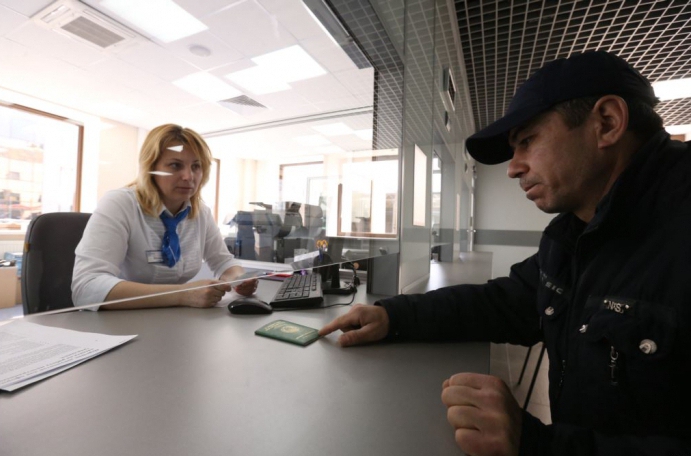
Patent Costs
A patent for labor migrants this year will cost its recipients 1,568 rubles. per month, while regional allowances for this amount are allowed. So, for Moscow, a monthly advance payment is 4000 rubles. in 2015.
Added to this is the cost of services. Their complete complex in Moscow is provided by the Unified Migration Center, located in the village of Sakharovo, 60 km from MKAD. The medical board here costs 3300 rubles, the exam for labor migrants will cost 4900 rubles.You can go through a medical board in Moscow (40 medical institutions are accredited for this), and you can also buy a medical insurance policy from an insurance company, but all this can be done directly in Sakharovo for 14,000 rubles, including the first payment for a patent.
How do migrant workers pass the exam?
Testing of labor migrants is carried out on a PC. Before it begins, examiners fill out handwritten forms with personal data. The test itself for knowledge of the Russian language, the foundations of the history and laws of the Russian Federation includes several sections.
First, the examiner should name the examiner the objects depicted in the pictures on the monitor screen. In the next test, you need to finish the phrase, for example, “It's cold outside today” with one of the following fragments: “Do not forget your passport”, “Dress warmly”, “Buy, please, food”.
Then, in writing, answer questions about who the president of Russia is today, what is the capital of Russia called, what kind of identity document, etc.
The exam is considered passed if scored at least 50 points out of 100 possible in all three parts of the test: language, history, law. If you can’t pass the first time, then you can retake an unlimited number of times during the one-month period of the initial stay in the Russian Federation. It also happens that a job applicant in Russia has to pass the exam three times.
According to the testimony of employees of specialized centers for passing such exams, the Russian language is often a problem for labor migrants, although they are explained in a fairly coherent way when communicating with employers. There are times when this test is retested several times.

Can the Chinese not learn Russian?
Migrant workers in Russia who have arrived for up to a year will soon not be required to pass the aforementioned exam. According to Boris Titov, the Presidential Commissioner for the Protection of Entrepreneurs' Rights, told a TASS correspondent during the Russian-Chinese forum "Big Opportunities for Small and Medium-Sized Businesses", many teams in the Far East are building shift teams for Chinese workers who come to the calendar quarter. It is unrealistic to demand from them knowledge of the Russian language and the history of Russia. Now the FMS is busy developing proposals for introducing relevant amendments to the migration legislation.
What is going on in the labor market?
Since the beginning of the year, this market is in a fever. Due to the depreciation of the ruble, tightening of immigration control and the introduction of patents for labor activity at the beginning of this year, the number of foreigners entering Russia was less than 70% compared to last year. Russian regions are exempted from labor migrants. The construction and tourist season began, the sowing season passed - and in all these areas there were not enough workers. Since the beginning of December last year, logistics and cleaning companies, traditionally hiring migrants, have experienced staff shortages.
Among the reasons are difficulties with paying the cost of documents required for obtaining patents, and without it, employers do not hire employees. In addition, passing examinations causes certain difficulties for migrants from Central Asia.
The FMS of Russia recently (in May) released data on the number of foreigners in the Russian Federation. Today, more than 2.1 million citizens of Uzbekistan, almost 1 million Tajiks, 0.6 million citizens of Kazakhstan, half a million citizens of Kyrgyzstan live in the country. In total, more than 4.2 million people were in Central Asia at the beginning of May. At the same time, there are 2.5 million Ukrainian citizens in Russia.
In total, according to the Director of the FMS, he said at a meeting with the President of the Russian Federation on May 6, 2015, there are up to 12.5 million foreigners in Russia, and the FMS fixes a slight decrease in their number.
And this happens not because of a reduction in entry, but by increasing exit, that is, measures taken by the authorities to regulate the immigration processes economically are working.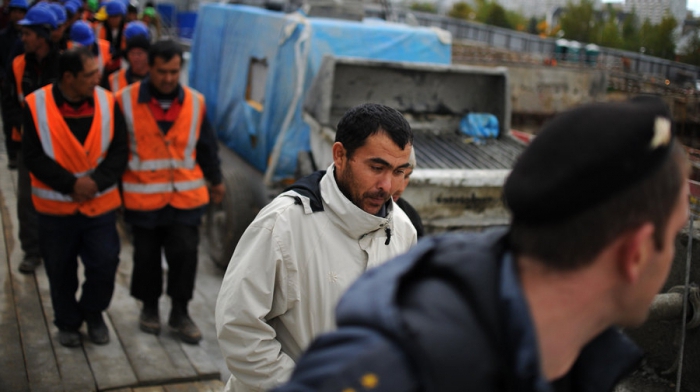
Will migrants go home?
About a million foreigners left Russia at the end of 2014, and a number of experts consider this the beginning of a persistent trend to reduce their numbers in our country. In their opinion, until the middle of 2016 there will be an even greater outflow, since less than half of those who receive a patent this year will renew it for next year. Only those with RPD or VU will remain.
However, according to other labor market analysts, the outflow of foreigners was seasonal, and closer to summer their numbers will recover. In fact, migrants have nowhere else to go to work, except for Russia. According to these estimates, the market can only experience episodic labor shortages, and the overall reduction in the number of labor migrants will not exceed 10-15%. To verify this, just look at the long lines of buying patents in Sakharovo near Moscow.
Some experts are of the opinion that Russians will replace migrants in vacant jobs, as is already the case in Central Russia. However, this will increase the cost of labor as a whole, which means that the cost of production will increase. How can one not recall the experience of American business, which transferred its main production (except defense) in the 80s of the last century to China and the countries of Southeast Asia. The purpose of this policy was precisely to reduce the cost of production due to lower wages.
Although today the number of legal migrants has almost tripled, their total number remains. Experts suggest that Russians may take part of vacant jobs. Now, due to the economic downturn, the need for labor in Russia has decreased compared to previous years. And in production companies, more and more vacant places are occupied by Russians. The results of January-February of this year clearly confirmed this trend. But working hands are still not enough. Some of the vacancies are occupied by citizens of Ukraine, who are increasingly interested in the possibilities of the Russian labor market, especially since passing examinations does not present any particular difficulties for them.
At the same time, housing and communal services and services, which in previous years stimulated the labor activity of migrants, will experience a shortage of labor. So, the experiment, aimed at attracting Russians to the place of the janitors, failed. At the beginning of the country there were 4 thousand such vacancies, and now there are already 8 thousand.
